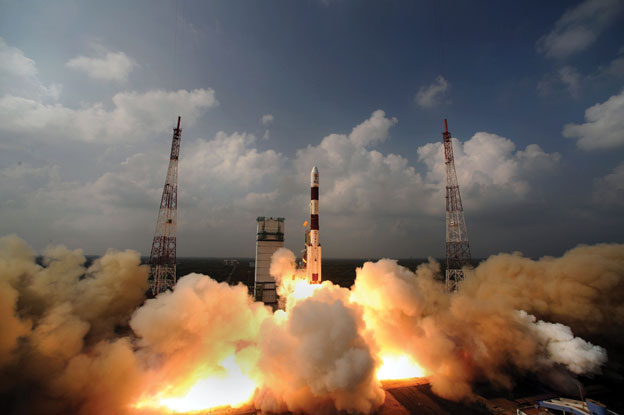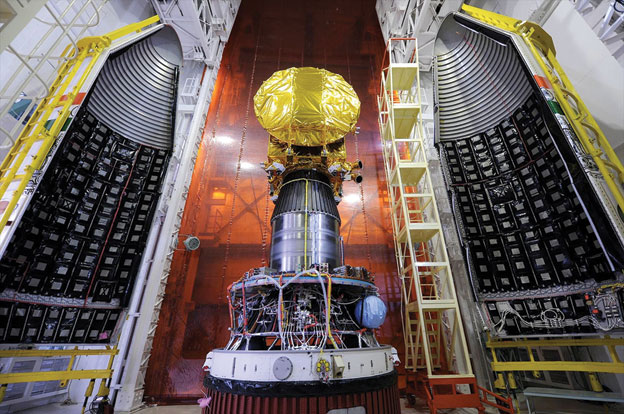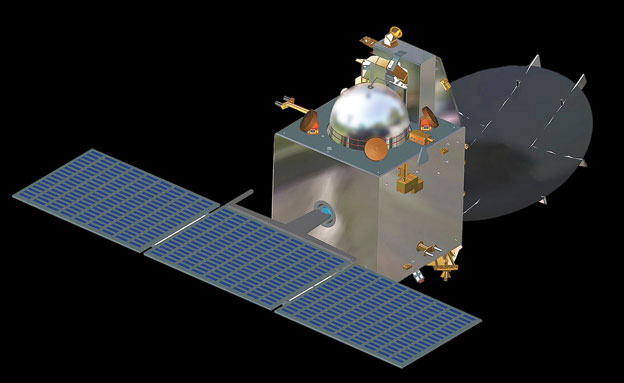SUBCONTINENT:
Space Obsession: India Launches Mars Orbiter Mission
When it comes to space exploration India vows not to be left far behind the super powers of the world. With the Mars Orbiter Mission, an assignment that has a 70 percent success rate for U.S. endeavors and rendered all Russian ventures almost fruitless, India has attempted to set for itself a difficult objective, and if successful, a new record of sorts would be created for others to emulate or envy, writes Priyanka Bhardwaj.

(Above): Handout photograph released by the Indian Space Research Organization on November 6, 2013, shows the PSLV-C25 rocket carrying the Mars Orbiter Spacecraft blasting off from the launch pad at Sriharikota. [Photo: ISRO]
The country’s premier scientific congregation belonging to India’s Space and Research Organization (ISRO) took immense pride in entering the Martian exploration mission by launching the indigenously built Rs. 4.5 billion Mars Orbiter Mission (MOM) on November 5.
The mission comes at a cost of one-tenth of what it normally would cost NASA or the European Space Agency and also would be the first endeavor to Mars that aims for success in its first try.
Before India only the U.S., Russia and Europe have achieved this feat and in all, there have been 40 missions.
Indian spacecraft “Mangalyaan” (Mars-craft) lifted off from Sriharikota, Nov. 5, 80 kilometers from Chennai in Tami Nadu, with the support of an evolved version of domestically developed Polar Satellite Launch Vehicle and fitted with extended rockets.
The satellite would be orbiting in an elliptical arc around the Earth and then pushed into higher orbit with a series of six small fuel burns before it slingshots toward Mars.
All that is known yet, as widely accepted by scientific community is that, Mars’ early atmospheric water and carbon dioxide seeped into the crust of the Martian surface as carbonate minerals and its gases escaped into space, heated and duly stripped away by the sun.

(Above): India’s first interplanetary probe, the Mars Orbiter Mission (MOM) spacecraft seen being prepared for launch from Satish Dhawan Space Center SHAR in Sriharikota, India. [Photo: ISRO]
MOM’s main mission is for it to employ its five solar powered instruments to survey the planet’s geology and atmosphere, discern reasons why water that once believed to be part of its systems disappeared, search for evidence of methane considered essential for life’s chemical processes and comprehend functional aspects of the planet’s weather systems.
The craft has been integrated with the technology that had enabled discovery of water on Moon when ISRO launched Chandrayaan-I in 2008-09.
During its 300-day long coursing around Mars and journeying 780 million kilometers (485 million miles), MOM’s closest point to Mars is to be 365 kilometers (227 miles), and at its furthest it would at 80,000 kilometers (49,700 miles).
Though the data that is sent back would be a tentative one, yet it is expected to be strongly indicative in nature and help researchers gain insights helpful for leads and directions for understanding and discoveries says ISRO Chairman Dr. K. Radhakrishnan.
The complex mission expected to demonstrate and advance technologies for space travel, was avidly followed by scientists and enthusiasts. But soon after the launch a glitch occurred when the craft was in its stages of fourth orbit raising operations.
However, latest information from ISRO office indicate that the last of the five orbit-raising maneuvers on Mars Orbiter have been accomplished and the apogee (farthest point from Earth) of the spacecraft has been raised to over 192,000 km.
The MOM will take on the crucial event of the trans-Mars injection on December 1, 2013 and is expected to reach the orbit of the red planet by September 24, 2014.

(Above): Artist’s illustration of India’s Mars Orbiter Mission probe. [Photo: ISRO]
India’s expensive and ambitious space missions have always endured a load of criticism especially as the nation grapples overwhelming poverty and the World Bank revealing an astonishing reality of 53 percent Indian households defecating in the open.
Pragmatists however are quick to point out dozens of reasons why the country could venture into such space programs.
Besides ushering in a new sense of enthusiasm and ‘can do’ spirit among young minds to be intrigued and interested in careers in the fields of science, technology and research, there are a slew of other benefits accruing from these adventures.
Over time, ISRO has brilliantly put into good use, its technology to enable other countries to put their equipment in space and sometimes for a handsome fee.
The current Mars mission could be a step towards innovation in cost and speed and a chance for the country’s resources to help it become a hub for space projects.
Besides more employment to engineers, technology firms could get an impetus to churn out more success oriented crafts and programs at an inexpensive price.
A space renaissance in the making, there may be ingenuous ways in which India could bring in more money and help humanity and thus advance human kind.
The MOM came at a time when the country’s political leadership did not ponder much on conferring the country’s highest civilian award, Bharat Ratna, to C.N. Rao who is an internationally decorated Indian chemist and is also Chair of Scientific Advisory Council to India’s Prime Minister.
Rao himself remarked that, “Very rarely science gets importance. For instance, I got the $1 million Dan David prize, which is equivalent to Nobel Prize in 2005, but nobody talks about it.”
Perhaps MOM would make a fresh start along the lines for furtherance in popularity of science among citizens.
NASA’s Maven Explorer
Not willing to be left behind on its own outer space quest, NASA has rocketed Maven (Mars Atmosphere and Volatile EvolutioN), the latest robotic explorer toward the red planet that is expected to land next fall after traversing a journey measuring 440 million miles or 700 million kilometers.
A space program agency that has already announced a human expedition by 2030, this would be NASA’s 21st mission to Mars since the 1960s and would orbit Mars unlike the earlier Curiosity Rover launched in 2011 and would cost a total of $671 million.
The mission is to unfold mysteries that have had the scientific community riddled, for instance the morphing of temperatures of Mars, from warm, wet and dense atmospheric times in its initial billion years of origin to cold and dry times of present according to Michael Meyer, NASA’s lead Mars scientist who spoke to the press.
This spacecraft, weighing 5,410 pounds and the size of a school bus, will spend an entire Earth year on the planet to sample and evaluate atmospheric gases.
What boggles the human mind is that if initial conditions were conducive to life on Mars then did life come into being?
To this, John Grunsfeld, science mission director of NASA replied, “We don’t have that answer yet, and that’s all part of our quest for trying to answer, Are we alone in the universe?”
|